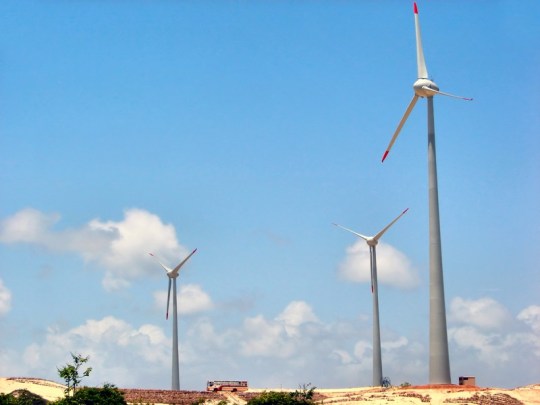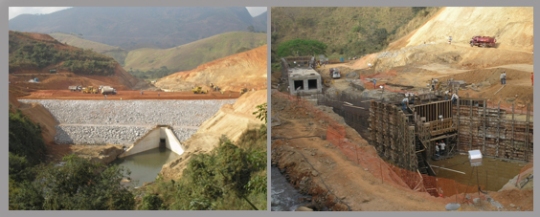Wind Power in Brazil: great potential, even better opportunities!
Brazil held its first wind-only energy auction in 2009, in a move to diversify its energy portfolio… and foreign companies scrambled to take part.
Some background
Soon after the millennium, a drought in Brazil that cut water to the country’s hydroelectric dams prompted severe energy shortages.
The crisis, which ravaged the country’s economy and led to electricity rationing, underscored Brazil’s pressing need to diversify away from water power.
The bidding is expected to lead to the construction of two gigawatts of wind production with an investment of about US$ 6 billion over the next two years.
Brazil counts on hydroelectricity for more than 3/4 of its electricity, but authorities are pushing biomass and wind as primary alternatives.
Wind energy’s greatest potential in Brazil is during the dry season, so it is considered as a good bet against low rainfall and the geographical spread of existing hydro resources.
Brazil’s technical potential for wind energy is 143 gigawatts due to the country’s blustery 4,600-mile coastline, where most projects are based.
The Brazilian Wind Energy Association and the government have set a goal of achieving 10 gigawatts of wind energy capacity by 2020 from the current 605 megawatts, with another 450 megawatts under construction.
The industry hopes the auction will help kick-start the wind-energy sector, which already accounts for 70% of the total in all of Latin America.

Plenty of Windfarms, mainly in the North East of the country... however many more are planned in the rest of Brazil.
Wind power in Brazil amounts to an installed capacity of 602 MW at the end of 2009, enough to power a city about 300,000 residences.
The 36 windparks and windfarms in the country, in 2009, were located in Northeastern Brazil (5 States), Southern Brazil (3 States), and Southeastern Brazil (1 State).
Potential of wind in Brazil is more intense from June to December, coinciding with the months of lower rainfall intensity.
This puts wind as a potential supplementary source of energy generated by hydroelectricity.
As of 2009, 10 projects were under construction, with a capacity of 256 MW. In 2010, 45 started construction to generate 2,139 MW, in several States around Brazil.
The U.S. company General Electric has one plant in Brazil, in the city of Campinas, and one partnership with Tecsis in Sorocaba, meeting the demand of the new projects.
While the 2009 United Nations Climate Change Conference (COP15) was taking place in Copenhagen, Brazil’s National Electric Energy Agency (ANEEL) held the country’s first ever wind-only energy auction.
On December 14 2009, around 1,800 megawatts (MW) were contracted with energy from 71 wind power plants scheduled to be delivered beginning from July 1, 2012.
While focusing domestically on wind-energy generation, Brazil is part of a larger international movement toward wind power as a primary source of energy.
In fact, wind power has seen the highest expansion rate of all available renewable energy sources, with an average growth of 27% per year since 1990, according to the Global Wind Energy Council (GWEC).
Government support for renewable energy
Brazil’s first wind-energy turbine was installed in Fernando de Noronha Archipelago in 1992.
Ten years later the government created the Program for Incentive of Alternative Electric Energy Sources (PROINFA) to encourage the use of other renewable sources, such as wind power, biomass, and Small Hydroelectric Power Stations (PCHs).
Such stations use hydropower, the flagship of Brazil’s energy matrix, which comprises around three-quarters of Brazil’s installed energy capacity.
High energy production costs, coupled with the advantages of wind power as a renewable, widely available energy source, have led several countries to establish regulatory incentives and direct financial investments to stimulate wind power generation.
Growth of wind energy in Brazil
Since the inception of PROINFA, Brazil’s wind energy production has escalated from 22 MW in 2003 to 602 MW in 2009, as part of 36 private projects. Another 10 projects are under construction, with a capacity of 256.4 MW, and 45 additional projects have been approved be ANEEL with an estimated potential of 2,139.7 MW. Developing these wind power sources in Brazil is helping the country to meet its strategic objectives of enhancing energy security, reducing greenhouse gas emissions and creating jobs. The potential for this type of power generation in Brazil could reach up to 145,000 MW, according to the 2001 Brazilian Wind Power Potential Report by the Electric Energy Research Center (CEPEL).
As you can see comparing these wind velocities and the previous map of current and planned projects… there are many areas of high potential (yellows and reds) which do not yet have windfarms installed or even planned past a concept stage.
Cost
The cost of energy production continues to pose a significant challenge to the growth of wind energy. The price per megawatt hour (MWh) established in Brazil’s auction of wind power reserve supply is R$189, while the cap defined in bidding for power plants of the Madeira River Hydroelectricity Complex was R$91 (UHE Jirau) in 2008, and R$122 (UHE Santo Antonio) in 2007. These hydroelectricity prices were marked down by up to 35% in the 2008 and 2007 auctions; the energy supply was negotiated at R$71.4/MWh in the case of Jirau, and R$78.9/MWh for the Santo Antonio plant.
To conclude… there is no conclusion.
Wind in Brazil is an ongoing subject, and I believe that Wind should be developed in as a priority source of energy. Even more so than Brazil’s hydro-electric system, and as is currently being debated in Congress in Brazil how it may have negative consequences on indigenous reserves by means of extensive flooding. This I will discuss at length in another article.
Let’s see if Brazil will not forget about Wind Energy now that Petrobras has made such lucrative finds of Oil and Gas offshore of Rio.
I am hopeful.
However if we wish to play a part in Brazil’s future… then we need to be in it, to win it!









